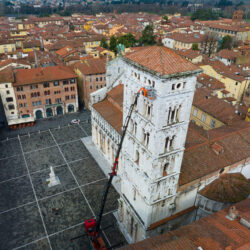Start
15/12/21
Other companies involved
- Giorgio Barbato (RUP)
- Consorzio “Venezia Nuova”
- Thetis SpA
- Rossi Renzo Costruzioni
- Kostruttiva
- San Marco Insula S.c. A R. L.
- Microgeo
Move Solutions Devices
PROJECT OVERVIEW
In order to protect St. Mark’s Basilica in Venice from high water, it was decided to build transparent glass sheets around it. Since the laying of the glass included excavations to be carried out very close to the Basilica, Digital Rilievi was chosen to monitor the two outermost columns of the façade and the two Pillars of Acre (Pilastri Acritani) placed on the right side of the Basilica, using Move Solutions sensors.
THE GLASS BARRIER PROJECT
St. Mark’s Basilica is considered one the symbols of the city of Venice but also one of the symbols of Venetian art and Christianity.
The glass barriers will protect the Basilica from high waters for the coming years. There are already some important barriers, the Mose barriers, built in the sea, to protect the city from high tides. The problem is that they only rise when water reaches 110 centimetres above sea level, but the Basilica already begins to flood when the water is at 65 centimetres above sea level. Since the Mose cannot be activated at those thresholds, as that would block too many port activities, the city decided to install glass barriers in order to protect the religious building, which would otherwise be underwater around 180 times a year, leading to serious problems of instability. This safety project will only be provisional (2/3 years), until the protection works of the entire insula of St Mark’s are completed.
MONITORING SYSTEM
The construction management decided to place the sensors on 4 monitoring points: on the two outermost columns of the façade of the basilica and on the two Pillars of Acre on the right. Two devices were placed on top of each structure, a Tiltmeter and an Accelerometer, in order to control both slow movements and any vibrations caused by the excavation activities. In addition to that, topographic monitoring is carried out on a monthly basis with a high-precision total station (0.5″), connected to a Single Channel Node. The comparison of different types of data helps to avoid errors. The sensor installation was non-invasive thanks to the use of stainless-steel clamps and PVC angular spacers, on which the devices were anchored.








